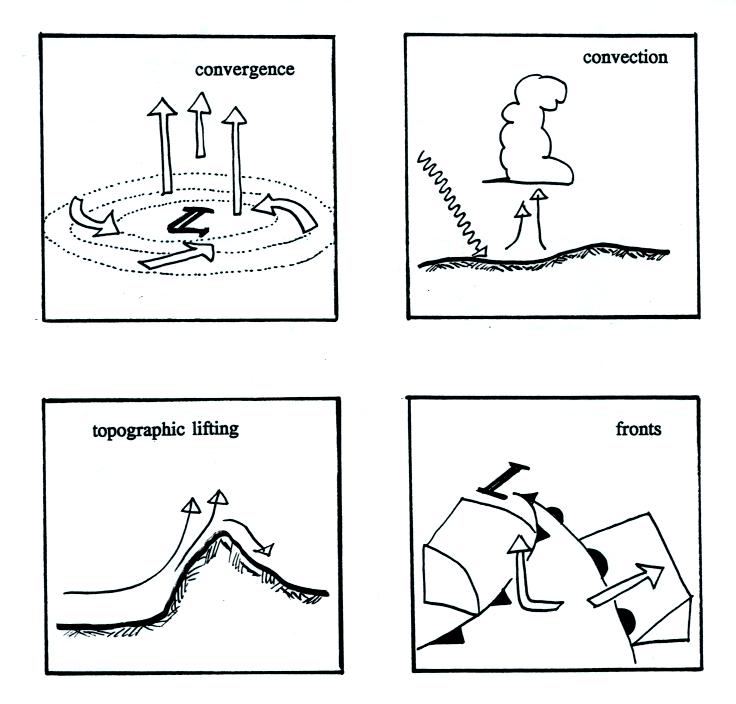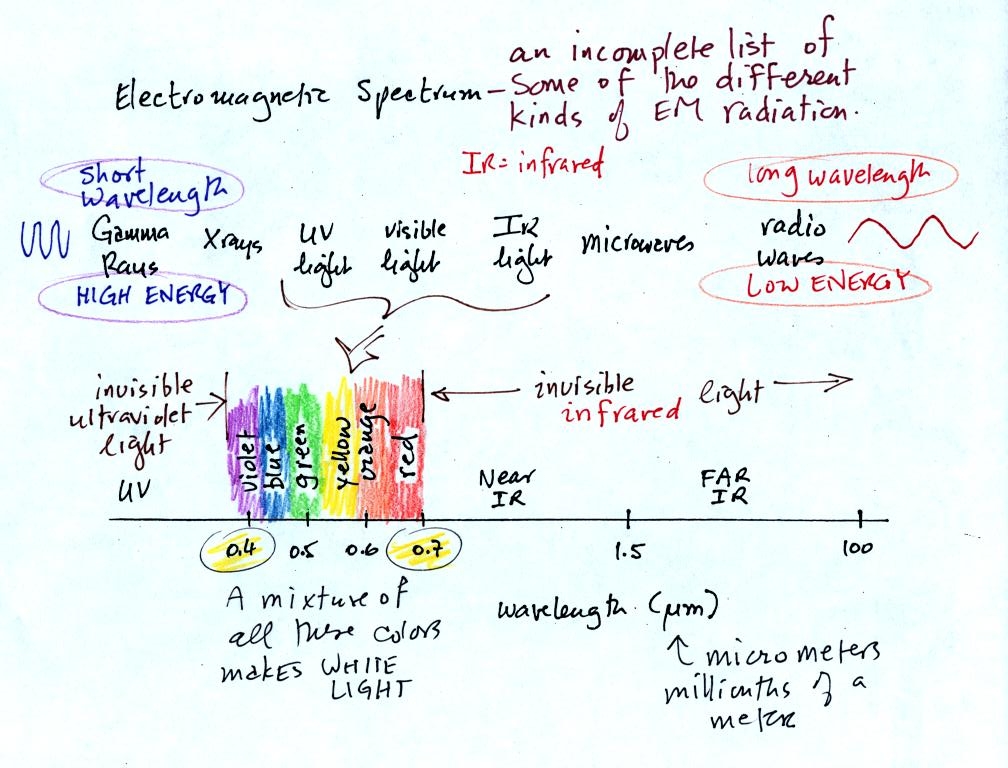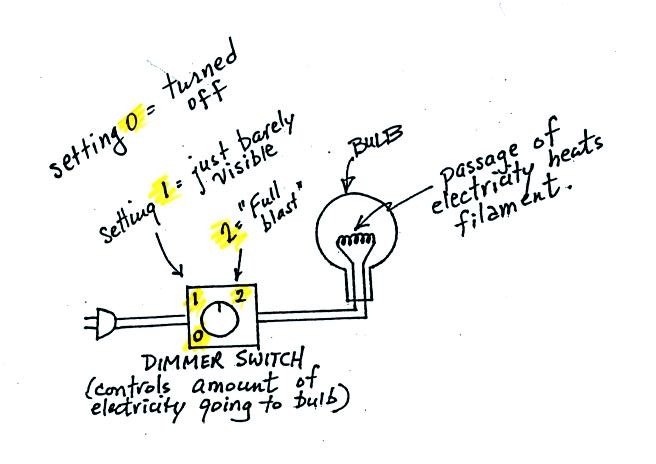There are 4 processes
that can cause air to rise. We've covered two of these,
convergence and fronts, already. The last two were snuck into
Friday's class. It is worth pointing them out again.
The first is illustrated in the upper right corner above.
Sunlight warms the ground which then warms the air in contact with the
ground. This warm low density air starts to rise. This is
free convection.
Air moving horizontally encounters a mountain in the figure above at
lower left. The air is forced to rise in order to get past the
mountain. This is topographic (or orographic) lifting.
The following figure wasn't shown in
class. It explains how energy can be transported from one
place to another (even through empty space) in the form of
electromagnetic (EM) radiation.
You add energy when you cause an
electrical charge to move up and down
and create the EM radiation (top left).
In the middle
figure, the EM
radiation then travels out
to the
right (it could be through empty space or through something like the
atmosphere).
Once
the EM radiation encounters an electrical charge at another location
(bottom right),
the energy reappears as the radiation causes the charge to move.
Energy
has been transported from left to right.
I'm in a
little bit of a rush today putting today the online notes. So
many of the remaining figures have been taken from the Fall 2008 notes
and may differ slightly from today's notes (mostly just the colors are
different)..
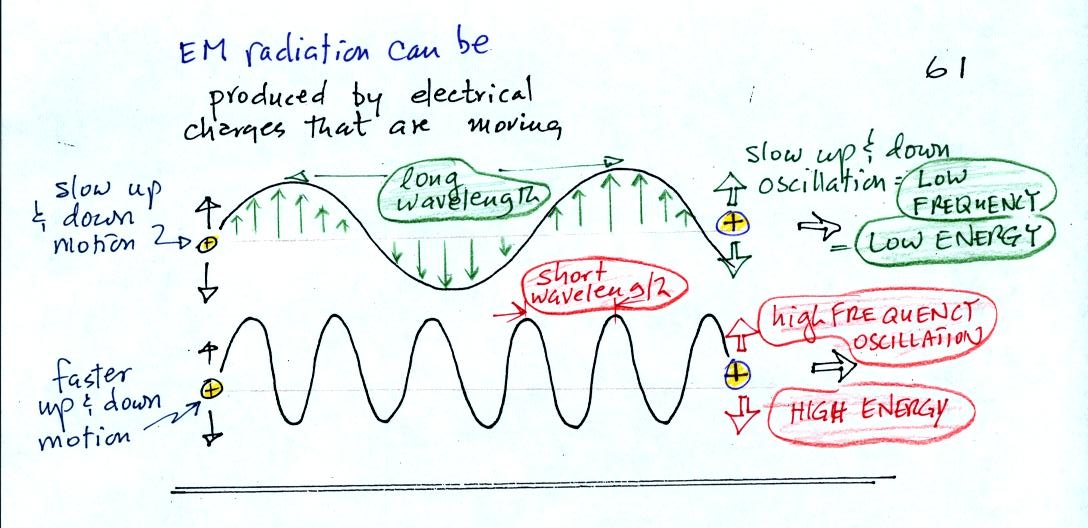
EM radiation can be created when
you cause a charge to move up and
down.
If you move a charge up and down slowly (upper left in the
figure above) you would produce long wavelength radiation that would
propagate out to the right at the speed of light. If you move the
charge up and down more rapidly you produce short wavelength radiation
that propagates at the same speed.
Once the EM radiation encounters the charges at the right side of
the
figure above the EM radiation causes those charges to oscillate up and
down. In the case of the long wavelength radiation the charge at
right oscillates slowly. This is low frequency and low energy
motion. The short wavelength causes the charge at right to
oscillate more rapidly - high frequency and high energy.
These three characteristics: long wavelength / low frequency / low
energy go
together. So do short wavelength / high frequency / high energy.
Note that the two different types of radiation both propagate at the
same speed.
This is really just a partial list
of some of the different
types of EM
radiation. In the top list, shortwave length and high energy
forms of EM radiation are on the left (gamma rays and X-rays for
example). Microwaves and radiowaves are longer wavelength, lower
energy forms of EM radiation.
We will mostly be concerned with just ultraviolet light (UV),
visible
light (VIS), and infrared light (IR). Note the micrometer
(millionths of a meter) units used for wavelength. The visible
portion of the spectrum falls between 0.4 and 0.7 micrometers (UV and
IR light are both invisible). All of the vivid colors
shown above
are just EM radiation with slightly different wavelengths. WHen
you see all of these colors mixed together, you see white light.
Here are some rules governing the emission of electromagnetic
radiation:
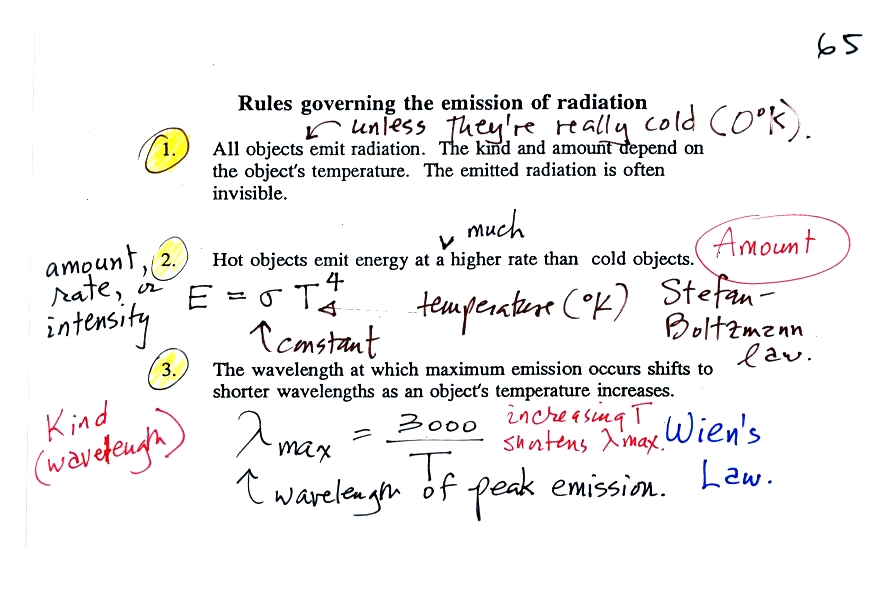
1.
Unless an object
is very cold (0
K) it will emit EM
radiation. All the people, the furniture, the walls and the floor
in the classroom even the air are emitting EM radiation. Often
this radiation
will be invisible so that we can't see it and weak enough that we can't
feel it. Both the amount and kind (wavelength) of the emitted
radiation depend on the object's temperature.
2.
The second rule allows you to
determine the amount of EM radiation (radiant energy) an object will
emit. Don't worry about the units,
you can think of this as amount, or rate, or intensity.
Don't worry about σ either, it is just a
constant. The amount depends on temperature to
the fourth
power. If the temperature of an object doubles the amount of
energy emitted will increase by a factor of 2 to the 4th power
(that's 2 x 2 x 2 x 2 = 16). A hot object just doesn't emit a
little more energy than a
cold object it emits a lot more energy than a cold object. This
is illustrated in the following figure:
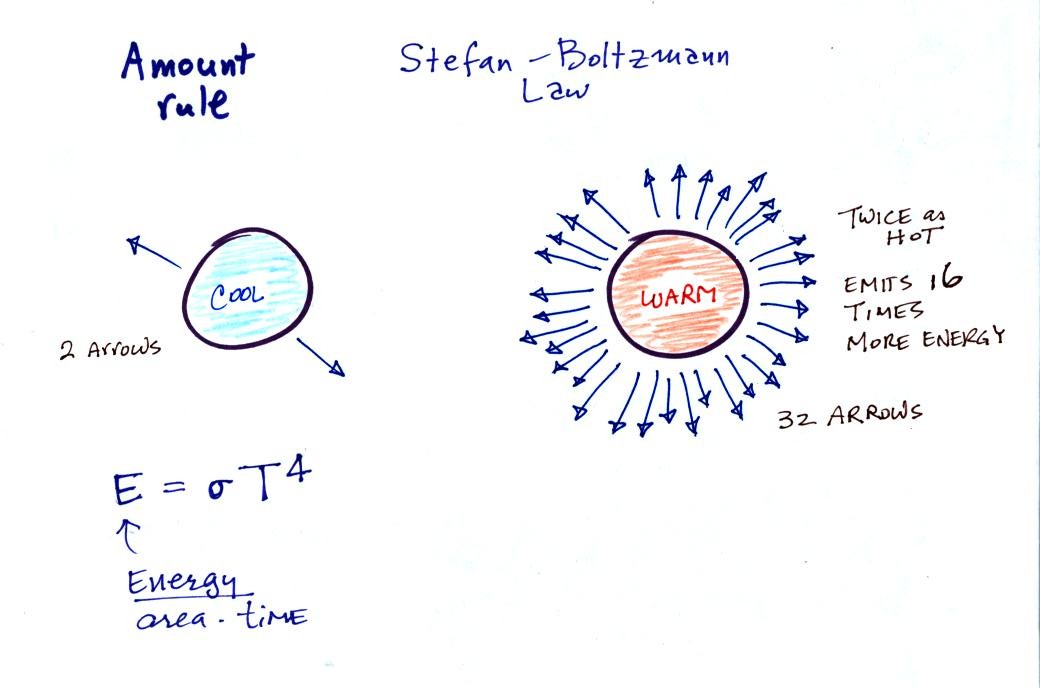
3.
The third rule tells you something
about the kind of radiation emitted
by an object. We will see that objects usually emit radiation at
many different wavelengths. There is one wavelength however at
which the object emits more energy than at any other wavelength.
This is called lambda max (lambda is the greek character used to
represent wavelength) and is called the wavelength of maximum
emission. The third rule allows
you to calculate "lambda max." This is illustrated below:

The
following graphs (at the bottom of p. 65 in the photocopied Class
Notes) also help to
illustrate the Stefan-Boltzmann law
and Wien's law.
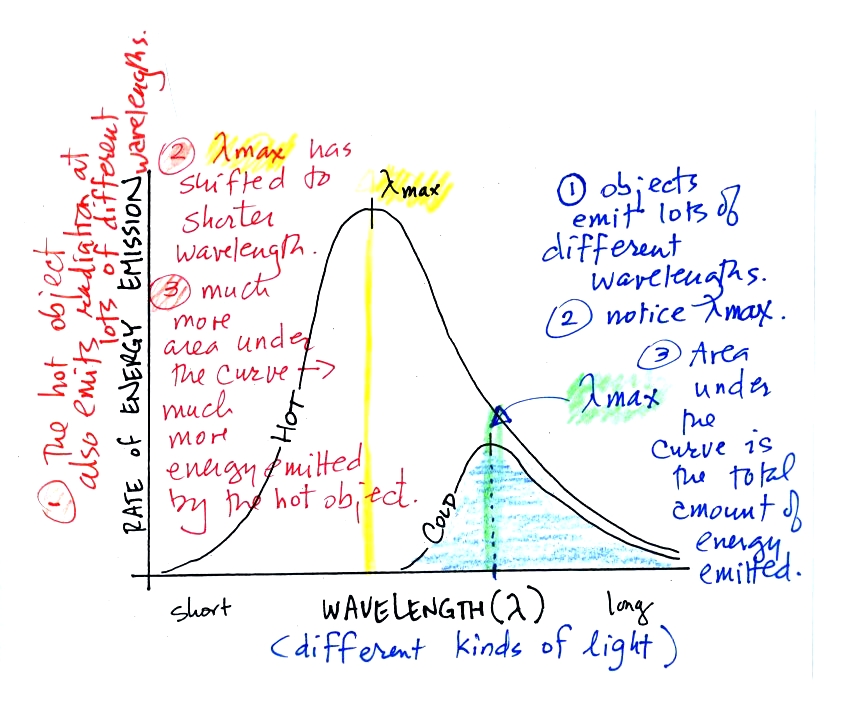
1.
Notice first that both and warm
and
the cold objects emit radiation
over a range of wavelengths (the curves above are like quiz scores, not
everyone gets the same score, there is a distribution of grades)
3.
The area under the warm object
curve is much bigger than the area under
the cold object curve. The area under the curve is a measure of
the total radiant energy emitted by the object. This illustrates
the fact that the warmer object emits a lot more radiant energy than
the colder object.
2.
Lambda max has shifted toward
shorter wavelengths for the warmer
object. This is Wien's law in action. The warmer object is
emitting lots of types of short wavelength radiation that the colder
object
doesn't emit.
An
ordinary 200 W tungsten bulb connected to a dimmer switch can be
used to demonstrate these rules (see p. 66 in the photocopied
ClassNotes). We'll be seeing the EM radiation emitted by the bulb
filament.
The graph at the bottom of p. 66 has been split up into 3 parts and
redrawn for improved clarity.
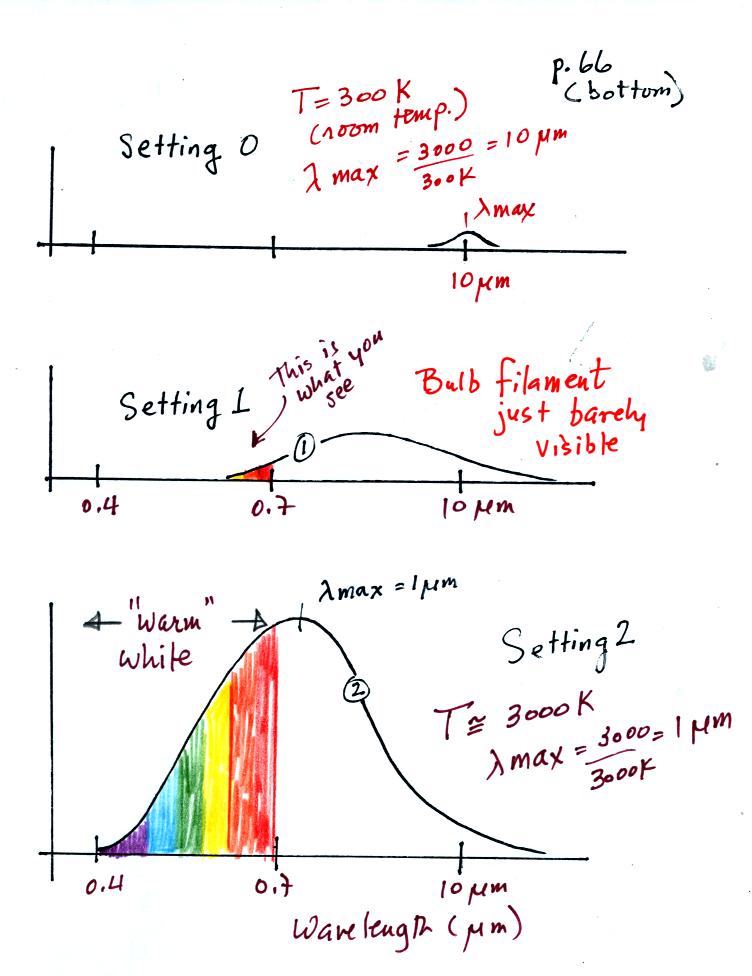
We start with the bulb turned off (Setting 0). The
filament will be at room temperature which we will assume is around 300
K (remember that is a reasonable and easy to remember value for the
average temperature of the earth's surface). The bulb will be
emitting radiation, it's shown on the top graph above. The
radiation is very weak so we
can't
feel it. It is also long wavelength, far IR, radiation so we
can't see it. The wavelength of peak emission is 10 micrometers.
Next we use the dimmer switch to just barely turn the bulb on (the
temperature of the filament is now about 900 K).
The bulb wasn't very bright at all and had an orange color. This
is curve 1, the middle figure. Note the far left end of the
emission curve has
moved left of the 0.7 micrometer mark - into the visible portion of the
spectrum. That is what you are able to see, just the small
fraction of
the radiation emitted by the bulb that is visible light (but just
long wavelength red and orange light). Most of the radiation
emitted by the bulb is to the right of the 0.7 micrometer mark and is
invisible IR radiation (it is strong enough now that you could feel it
if you put your hand next to the bulb).
Finally we turn on the bulb completely (it was a 200 Watt bulb so it
got
pretty bright). The filament temperature
is now about 3000K. The bulb is emitting a lot more visible
light, all the colors, though not all in equal amounts. The
mixture of the colors produces a "warm
white" light. It is warm because it is a mixture that contains a
lot more red, orange, and yellow than blue, green, and violet
light. It is interesting that most of the radiation emitted by
the bulb is still in the IR portion of the spectrum (lambda max is 1
micrometer). This is
invisible light. A tungsten bulb like this is not especially
efficient, at least not as a source of visible light.
You were able to use one of the diffraction gratings to
separate the
white light produced by the bulb into its separate colors.
When you looked at the bright white bulb filament through one of the
diffraction gratings the colors were smeared out to the right and left
as shown below (the following two
figures weren't shown in class):

Some of the grating handed out in class behaved a little differently
and spread out the colors horizontally, vertically, and diagonally.

The sun
emits electromagnetic radiation. That shouldn't come as a surprise
since you can see it and feel it. The earth also emits
electromagnetic radiation. It is much weaker and invisible.
The kind and amount of EM radiation emitted by the earth and sun depend
on their respective temperatures.

The curve on the left is for the sun. We first used Wien's
law and a temperature of 6000 K to calculate lambda max and got
0.5 micrometers. This is green light; the sun emits more green
light than any other kind of
light. The sun doesn't appear green because it is also emitting
lesser amounts of violet, blue, yellow, orange, and red - together this
mix of
colors appears white. 44% of the radiation emitted by the sun is
visible light, 49% is IR light (37% near IR + 12% far IR), and 7%
is ultraviolet light. More than half of the light emitted by the
sun is invisible.
100% of the light emitted by the earth (temperature = 300 K) is
invisible IR light. The
wavelength of peak emission for the earth is 10 micrometers.
Because the sun (surface of the
sun) is 20 times hotter than the earth a square foot of the sun's
surface emits energy at a rate that is 160,000 times higher than a
square foot on the
earth. Note
the vertical scale on the earth curve is different than on the sun
graph. If both the earth and sun were plotted with the same
vertical scale, the earth curve would be too small to be seen.
